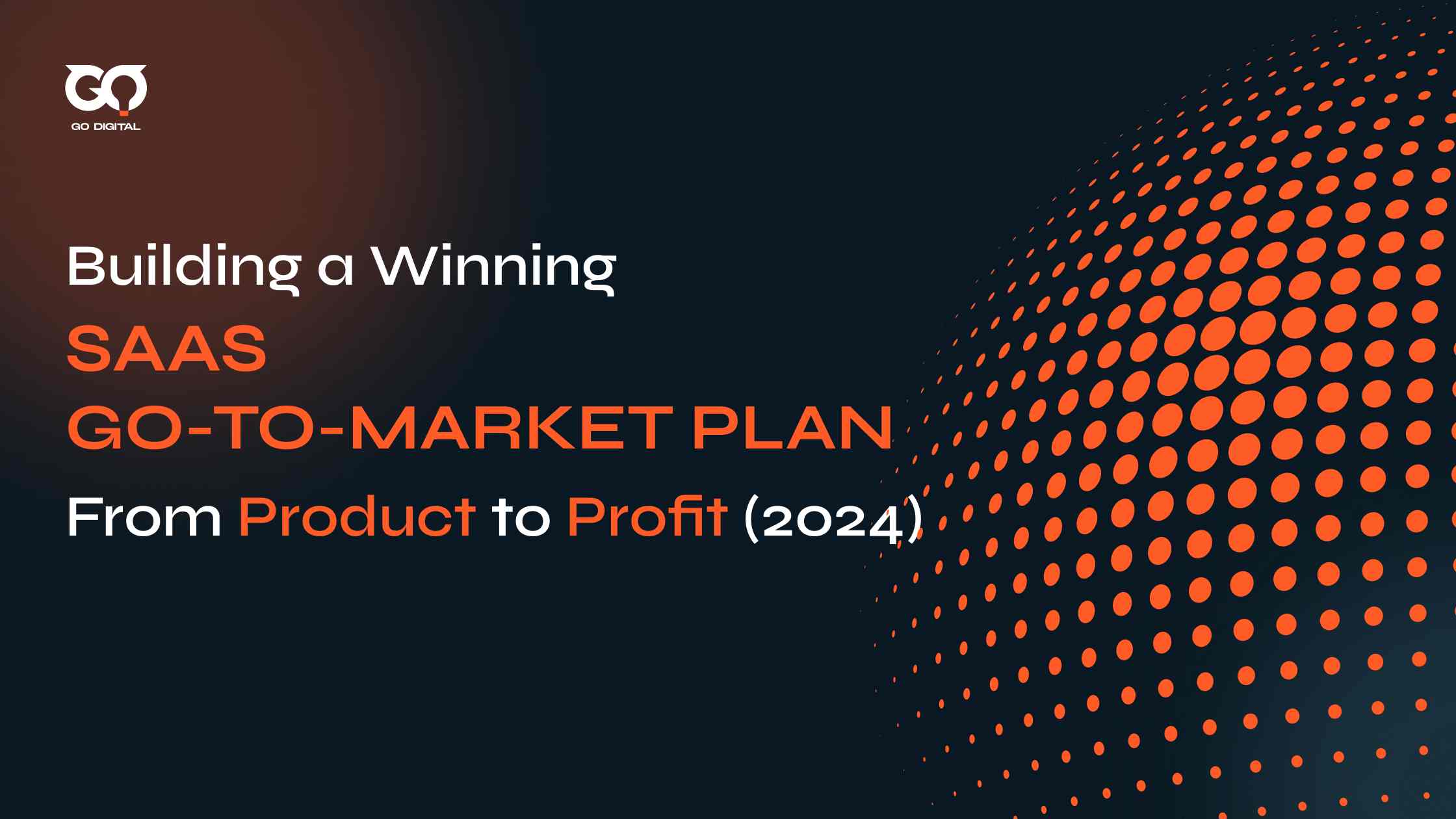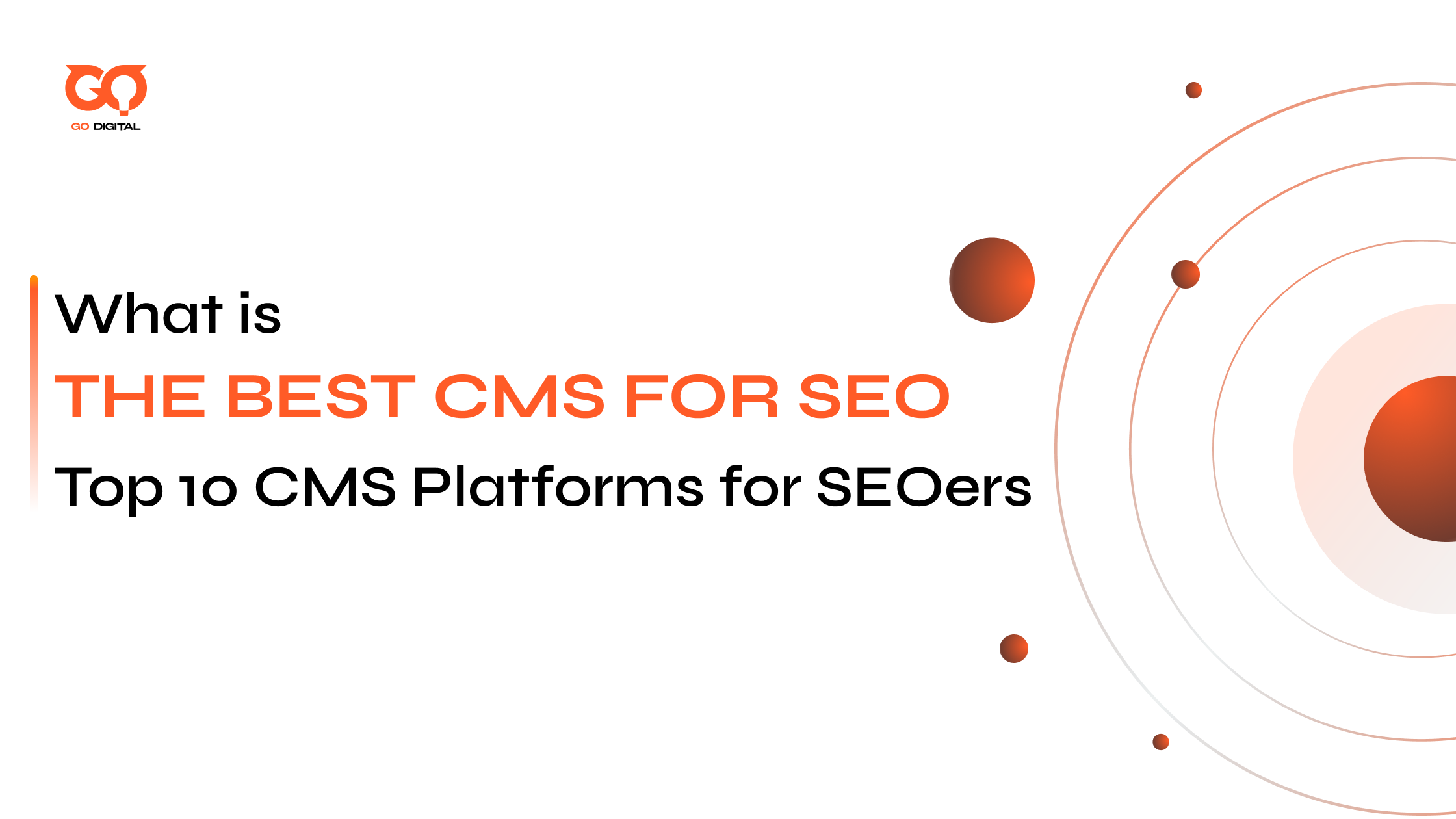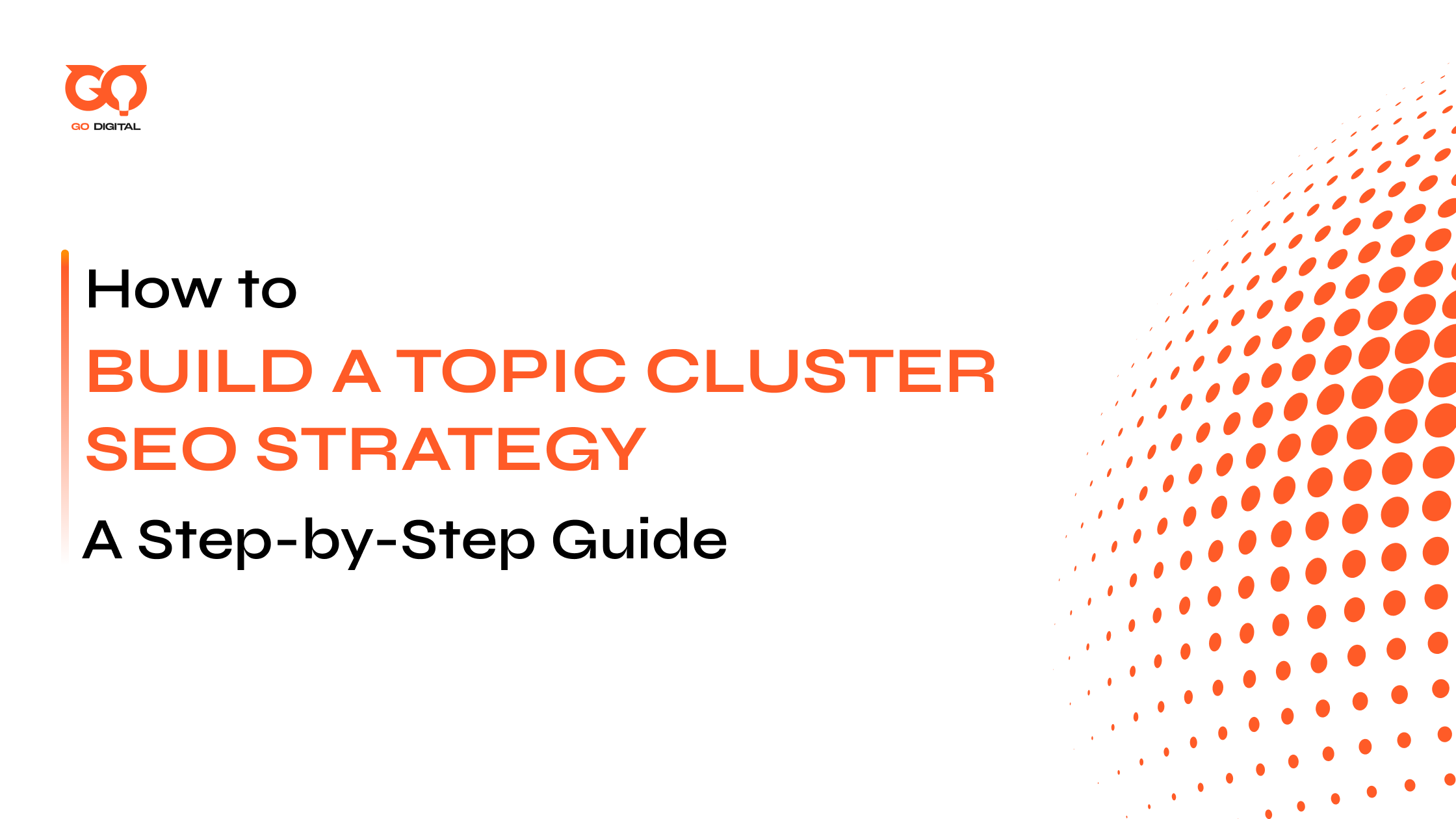Launching a SaaS product is just the beginning—the real challenge is getting it in front of the right people. To stand out and scale, you need a clear SaaS go-to-market strategy to reach and resonate with your ideal customers.
This guide will walk you through the essentials to make sure your launch is not just noticed but embraced. Let’s start!
| 🎯 Key Takeaways |
| A well-defined GTM strategy ensures your product reaches the right audience at the right time. Every SaaS needs a GTM strategy to connect your product with the people who need it most (and most likely are willing to pay for it). Building a GTM strategy involves identifying target buyers, analyzing the market and competition, and planning actions to drive user adoption and sales. |
Part 1: Defining GTM
What Is a SaaS Go-To-Market Strategy?
A SaaS (Software as a Service) Go-To-Market (GTM) strategy is a comprehensive plan that outlines how a company will sell its software product to customers in their target market. It serves as a roadmap for launching a product in the market and achieving business objectives.
A well-defined GTM strategy is essential for any SaaS business, since it will lead to the right product → reaching the right audience → at the right time.
What Goes Into Building a GTM Strategy for SaaS?
At its core, a SaaS GTM strategy includes several key components that can be divided into STAR framework:

S – Situation
This component involves understanding the current market landscape and the context in which your SaaS product will operate. Key elements include:
- Market Analysis: Assess the overall market size, trends, and growth potential. Identify key players and emerging competitors.
- Customer Needs: Research the specific problems and pain points faced by your target audience. This may involve surveys, interviews, or analyzing existing data.
- SWOT Analysis: Conduct a SWOT analysis (Strengths, Weaknesses, Opportunities, Threats) to evaluate your product’s position relative to competitors and market conditions.
T – Task
In this phase, you define the objectives and goals for your GTM strategy. This includes:
- Clear Objectives: Establish what you want to achieve with your launch, such as user acquisition targets, revenue goals, or market penetration rates.
- Target Audience: Identify the specific segments of the market you intend to focus on, creating detailed buyer personas that represent your ideal customers.
- Key Metrics: Determine the metrics that will guide your strategy, such as customer acquisition cost (CAC), lifetime value (LTV), and churn rate.
A – Action
This component outlines the specific steps and initiatives you will implement to achieve your objectives. Key actions include:
- Value Proposition Development: Craft a compelling value proposition that clearly communicates the unique benefits of your SaaS product.
- Marketing Strategy: Plan your marketing tactics, including content marketing, social media campaigns, email marketing, and partnerships to generate leads.
- Sales Strategy: Define your sales approach, including pricing models, sales funnels, and customer onboarding processes to ensure a smooth transition from prospect to user.
- Customer Support: Develop a customer support plan to assist users post-launch, enhancing their experience and encouraging retention.
R – Result
The final component focuses on measuring the outcomes of your GTM strategy. This involves:
- Performance Metrics: Monitor key performance indicators (KPIs) to assess the effectiveness of your strategy. This includes tracking user acquisition rates, engagement levels, and customer satisfaction scores.
- Feedback Loops: Establish mechanisms for gathering customer feedback to understand their experiences and identify areas for improvement.
- Adjustments and Iterations: Use the data collected to refine your strategy over time, making necessary adjustments to better meet customer needs and improve overall performance.
In a nutshell, a Go-to-Market (GTM) strategy typically includes market analysis, competitor evaluation, target audience identification, value proposition, sales and marketing strategies, pricing strategy, distribution plan, and key performance indicators (KPIs).
Why Every SaaS Product Needs a Go-To-Market Strategy?
Every SaaS product needs a Go-To-Market (GTM) strategy because of one primary goal: creating the lifeline between your product and the people who need it most.
Typically, SaaS businesses set ambitious revenue goals. For example, let’s say the target is $100 million in annual revenue. Christoph Janz from Point Nine Capital, came up with a model that helps figure out how many paying users you need to hit that target: the Flies-Elephants model.
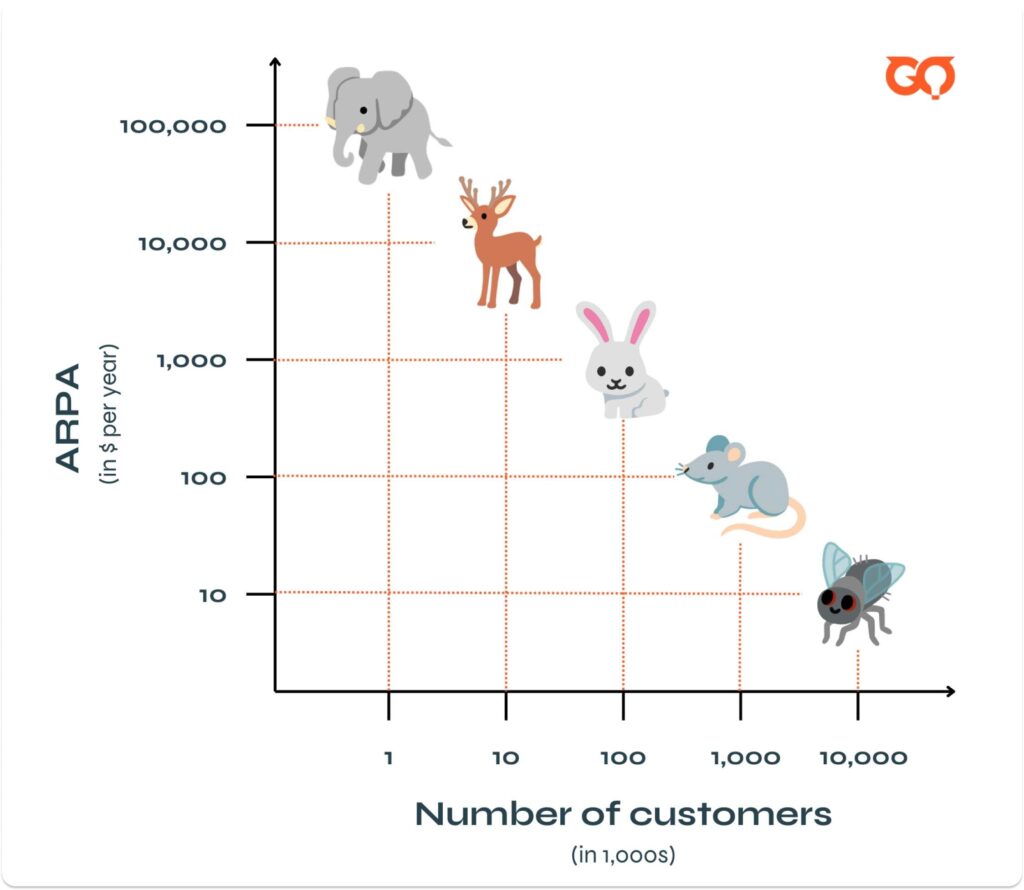
It goes something like this:
“To build a Web company with $100 million in annual revenues, you essentially need:
- “Elephants”: 1,000 enterprise customers paying you $100k+ per year each;
- “Deers”: 10,000 medium-sized companies paying you $10k+ per year each;
- “Rabbits”: 100,000 small businesses paying you $1k+ per year each;
- “Mice”: 1 million consumers or “prosumers” paying you $100+ per year each (or, in the case of eCommerce businesses, 1M customers generating $100+ in contribution margin per year each);
- “Flies”: 10 million active consumers who you monetize at $10+ per year each by selling ads”
Now, if your goal is to secure the 1,000 high-paying “Elephants,” your approach needs to be entirely different from the strategy you’d use to attract the 10 million “Flies.” Enterprise customers require a tailored, high-touch sales process, deep relationship building, and perhaps even custom solutions. In contrast, reaching millions of individual consumers often involves mass marketing, scalable solutions, and automated processes.
This is where a well-crafted Go-To-Market (GTM) strategy becomes crucial to reach your target buyers. To put into perspective:
- For “Elephants,” your GTM strategy might focus on targeted outreach, industry-specific marketing, and personalized demos or consultations.
- On the other hand, capturing “Flies” would likely require a strategy centered on digital marketing, freemium models, and viral growth tactics.
Part 2: Building a GTM
Step 1: Laying down the foundation
1. Buyer persona
“Wait, not target audiences or customer persona?”
While target audiences and customer personas provide a broad ideal view, a buyer persona is more purchase-focused customer persona, which is extremely helpful for the SaaS industry. It’s a detailed, purchase-oriented profile that hones in on the specific type of customer you want to reach.
A buyer persona typically includes a blend of demographic and psychographic details, complete with a name and face (often a stock photo) to make them more relatable and visualized. To build an effective persona, start by answering some key questions:
- Who are you launching the product to first? Early adopters, small businesses, or enterprises?
- What problems keep them up at night?
- What group of people will benefit most from your product? Who will become your champions?
- What do they hope to achieve?
- Who influences their decision-making process? Is it the CTO, CFO, or perhaps a department head?
2. Value proposition
Your value proposition is the core of your GTM strategy. It’s the unique value your product offers that differentiates you from competitors. Clearly articulate how your product solves problems, fulfills needs, or enhances the life or business of your customers.
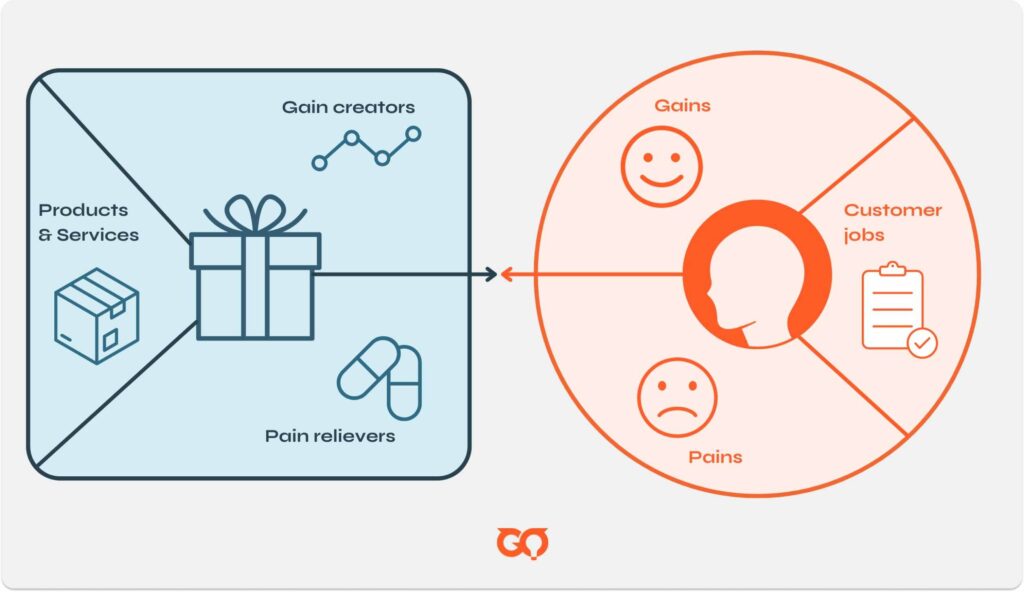
You can use the Value Proposition Canvas to help align your product with your customers’ specific needs. (which we also highly recommend in our article about SaaS product marketing tactics!)
It identifies who your target audience is, what problems they face, and what goals they want to achieve. On the product side, focus on how your solution addresses their pain points, delivers desired outcomes, and stands out from competitors. Be sure to incorporate your brand promise by clearly defining what your product offers and ensuring you can consistently deliver on it.
Mapping these elements together, you can create a compelling, targeted value proposition that enhances your GTM strategy and resonates with your audience.
3. Pain points & solutions
Identify the specific problems your target customers face—what’s frustrating them, what slows them down, or what they need to improve.
Then, match each pain point with a clear, practical solution your product provides. Show exactly how your product makes their life easier or business better.
The more directly you address these pain points, the more likely customers will see your product as the answer they’ve been looking for.
For example, let’s say your product is a B2B project management software:
- Pain Point: “Too much time spent on manual tracking.”
- Solution: Automated tracking saves time.
4. Key messages
Develop key messages that convey your value proposition and solutions in a compelling way.
These messages should be tailored to each buyer persona, focusing on what matters most to them.
Key messages will be used across all your marketing and sales channels to ensure consistency and clarity in how you communicate with your audience.
Same goes, take the pain point and solution to make a key message:
- For Operations Managers: “Automate your project tracking and save hours every week—our tool keeps your projects on time and your teams focused on what matters”
- For Team Leaders: “Enhance collaboration with your remote teams—our integrated tools ensure everyone stays connected and productive, no matter where they are”
- For Executives: “Never miss a deadline again—our real-time dashboards give you a clear, up-to-the-minute view of all your projects”
Step 2: Analyzing the competition
Key Questions to Answer:
- Who are your main competitors?
- What are their strengths and weaknesses?
- How does your product differ from theirs?
- What opportunities do you see that competitors are missing?
- How might competitors react to your product, and how can you stay ahead?
This step isn’t just about knowing who your competitors are, but about understanding what they do well, where they fall short, and how you can differentiate your product. Here’s how to approach it:
Competitor Benchmarking:
- Product Comparison: Compare your product with competitors’ offerings. What features do they have? How do they perform? This helps you identify where your product stands out.
- Marketing & Sales Strategies: Look at how competitors are marketing their products. What messages are they using? Which channels are they active on? Understanding their strategies helps you find opportunities to do something different or better.
- Customer Feedback: Read reviews and listen to what customers are saying about your competitors. This can reveal their strengths and weaknesses from the customer’s perspective.
Step 3: Building the SaaS GTM strategy
With a thorough understanding of your competitors and the market, it’s time to build a strategy that guides your product’s success.
Your strategy should consider whether a sales-led or product-led approach is best for your business, as well as how to align your marketing, sales, and product development efforts.
Sales-Led Strategy
In a sales-led approach, growth is driven by a strong sales team that actively engages with potential customers, often through direct outreach, demos, and relationship-building. This approach is typically used in markets where the product is complex or requires a consultative selling process.
1. Define Target Markets: Clearly define and list out market segments that are likely to benefit from a direct, personalized sales approach. Use insights from your competitive analysis to target industries, company sizes, or geographies where your product has a strong fit.
2. Craft Your Value Proposition: Develop a value proposition that addresses the specific needs and pain points of your target customers. Train your sales team to communicate this value effectively during sales pitches, demos, and negotiations.
3. Build a Strong Sales Team:
- Action: Hire and train a sales team with deep knowledge of your industry and product. Equip them with the tools and resources they need, such as CRM systems, sales enablement materials, and product demos.
- Outcome: A capable and motivated sales force ready to engage with potential customers.
4. Develop a Sales Process:
- Action: Establish a clear sales process, from lead generation to closing the deal. Define key stages in the sales funnel, set sales quotas, and identify metrics to track performance.
- Outcome: A structured sales process that ensures consistency and efficiency.
5. Execute Lead Generation Campaigns:
- Action: Run targeted lead generation campaigns using channels like email marketing, webinars, industry events, and partnerships. Focus on generating high-quality leads that align with your target segments.
- Outcome: A steady flow of qualified leads for your sales team to pursue.
6. Measure and Adjust: Regularly review sales performance metrics such as conversion rates, deal size, and sales cycle length. Use this data to refine your sales strategies, adjust quotas, and optimize your approach.
Product-Led Strategy
A product-led strategy focuses on the product itself as the primary driver of customer acquisition, retention, and expansion. The idea is to deliver a product experience that is so compelling that it attracts users organically, often through free trials, freemium models, or viral product features. This approach works well for products that are easy to adopt and have a clear value proposition.
1. Define Target Markets: Identify market segments where users can easily adopt your product on their own. Focus on a list of segments that are likely to benefit from self-service models or viral product features.
2. Craft Your Value Proposition: Create a value proposition that highlights the simplicity, ease of use, and immediate benefits of your product. Ensure this message is communicated clearly across all touchpoints, including your website, onboarding, and in-app experiences.
3. Optimize the Product Experience:
- Action: Focus on delivering an exceptional product experience. This includes simplifying onboarding, enhancing usability, and continuously improving features based on user feedback. Implement in-product prompts, tooltips, and tutorials to guide users.
- Outcome: A product experience that drives user adoption, engagement, and retention.
4. Apply Freemium or Trial Models:
- Action: Offer a freemium version or free trial to attract users and allow them to experience the product’s value before committing to a purchase. Use data to track trial conversions and identify opportunities to improve the trial-to-paid conversion rate.
- Outcome: A growing base of users that can be converted into paying customers.
5. Implement Product-Led Growth Tactics:
- Action: Use product-led growth tactics like in-app referrals, user-generated content, and community-building to expand your user base. Encourage users to share the product with others through built-in incentives.
- Outcome: Organic growth driven by the product itself and satisfied users.
6. Measure and Adjust: Track key product-led metrics such as user activation, engagement, churn, and Net Promoter Score (NPS). Use this data to iterate on the product, optimize the user journey, and drive higher retention and growth.
| 🎯 Pro tip: Either be the pioneer, or close to be a pioneer |
| Every GTM strategy has its own flavor, but you’ll often find common threads across different approaches by many top startups all around the world. While there might not be a one-size-fits-all GTM strategy for your startup, it’s beneficial to look at how they have carved their own paths through various development stages. So, feel free to draw inspiration from businesses you admire—just remember to make it your own unique strategy! Every now and then, we also adopt some innovative concepts that can help mitigate risks during our clients’ marketing process, as it minimizes uncertainties and allows for a more informed approach. A key aspect of this process is being open to experimenting with different ideas and analyzing the feedback you receive. One great method to do this is creating a Minimum Viable Product (MVP), a simplified version of the product that includes essential features to attract interest and gather early customer feedback for refinement. |
Bottom Line
A successful SaaS go-to-market strategy is all about precision—knowing your market, crafting a compelling message, and choosing the right channels to reach your audience.
Your go-to-market strategy is the backbone of this process, ensuring your product doesn’t just launch but thrives. Remember, the effort you put into planning your strategy now will pay off when your SaaS product starts gaining traction and driving results.
We hope this article has been a great help for you! Stay tuned on GO Digital’s Blog for more insightful and up-to-date industry knowledge.
Reference
1. https://whereby.com/blog/tech-founders-guide-to-go-to-market-strategy/
2. https://www.cognism.com/blog/what-is-a-go-to-market-strategy
3. https://www.eleken.co/blog-posts/saas-go-to-market-strategy


